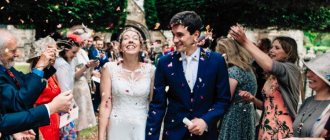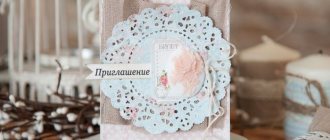The Russian style was formed in the 8th century in Kievan Rus. Its distinctive features are the richness of decoration and brightness of colors. The style is reminiscent of a fairy tale. A striking example for the formation of a general picture of style attributes is the fabulous work “Morozko”. In those centuries in Rus', the wedding ceremony was considered sacred; it required a lot of preparatory stages and events. The newlyweds were expected to carefully prepare for the celebration.
Nowadays, you reserve the right whether to observe all the nuances or make a celebration with an emphasis on style. In any case, the wedding will be bright and memorable.
Traditions, rituals and customs
The main stages of the celebration are:
- Collusion. Previously, the bride and groom might not even know each other before the wedding. Everything was decided without their direct participation. Parents often chose the wedding day themselves, discussed the size of the dowry and all the expenses for the celebration.
- Matchmaking. The groom, together with matchmakers (friends, godparents, parents) went to the bride's house to get married. Traditionally, the matchmakers were always refused the first time; they could give consent a second or only a third time. Matchmaking, after the consent of the parties, always turned into a real holiday with songs, dances and rich feasts.
- Hen-party. This event took place the night before the wedding. The girls went to the bathhouse, sang songs, and performed fortune telling by candlelight for the future of the bride.
- Bachelor party. This event was a lonely trip of the groom to wash himself in the bathhouse. According to tradition, after this trip the guy came home and went to bed; he had to remain silent until he met the bride.
- Ransom. Despite all the decisions and agreements, the groom had to pay the bride's parents for abuse. Also, relatives of the bride arranged all sorts of competitions and obstacles for the groom on the way to the bride. The young man needed to demonstrate strength, intelligence, generosity and kindness. When all the obstacles were over, the last thing left was to pay the agreed amount to the parents and find the bride. She was hidden not in the house, but in the yard or even with neighbors. The bride was guarded by her brother or father, who also had the right to demand a ransom. After all the competitions, the bride and groom received their parents' blessing and sat down for a small feast in the bride's house.
- Wedding and registration. The first step to forming a new family was going to church and holding a wedding ceremony. Only after the wedding was the marriage registered. This can be either an outdoor ceremony or registration at the registry office or even in a banquet hall.
- Celebration. The real fairy tale and fun begins after all the rituals. The celebration consists of a rich feast, the performance of Russian folk songs and playing musical instruments, dancing, round dances, competitions (running in sacks, collecting bagels on a pole or tree, tug of war), sleigh rides with dogs or on a cart with horses, all this with songs and the ringing of bells.
- Wedding night or basement. The place for the wedding night of the young couple was arranged very carefully. In a closet, barn or bathhouse in the groom's house, a high bed was placed, which was covered with feather beds and a bedding from the bride's dowry. Various amulets were laid out on the bed by the women who were bedridden. Logs, a poker, a juniper branch and a frying pan were placed under the bed. These items were supposed to protect the young from evil spirits. The newlyweds were escorted to the bedchamber by the whole crowd and locked. The girl always took off the guy’s boots, thereby showing humility in front of her husband. And she always asked permission to lie next to him. The morning after the wedding, the newlyweds’ bed was shown to all relatives to convince them of the bride’s innocence. Otherwise, the girl could be returned to her parents' house, a collar would be hung around the matchmaker's neck, and the father would be given a glass of wine with a hole in the bottom. The whole family was brought shame.
- Bad wedding. It is held on the second day and serves as an event for the entertainment of guests. The bride and groom are chosen from those present and made into mummers. The man is dressed up as a bride, the woman, respectively, as the groom. Their retinue also includes mummers (gypsies, buffoons, and so on). The whole cheerful crowd of this procession goes for a walk through the village, the “young” treat passers-by with snacks and vodka, and ask for money in return.
Wedding ceremony in the tradition of our Ancestors
The wedding rites of the Slavs, characteristic of the traditional culture of the Slavic-Aryans who lived on the territory of modern Russia tens of thousands of years ago, represent a structurally simple, and at the same time incredibly deep from the point of view of the ideological-figurative paradigm, a system of ritual actions aimed at maximum synchronization of the energy structures of the two of people.
Simply put, in contrast to the essential features of the current institution of marriage, the wedding rites of the Slavs were not reduced to a “stamp in the passport” followed by an enchanting drunkenness. For our Ancestors, a wedding, or rather Lubomir, was a ritual thought out to the smallest detail, which began long before the mass celebration, although such, of course, took place. In fact, the beginning of Lyubomir was the traditional exchange of rings between the bride and groom (“betrothal”, from the Old Russian name for the ring - “hoop”). This action could be performed either in private, without informing anyone, or in the presence of friends or relatives. In any case, the groom notified the bride's family in advance of his intention and without fail received a blessing from both his parents and the parents of his chosen one. In the process of exchanging rings (necessarily silver, because silver is the most energy-intensive metal), the groom gave the bride a ring that he had previously worn for quite a long time, ideally from the age of twelve or sixteen. In return, the bride gave the groom her ring, which she had also worn for many years. However, the rings received by the bride and groom were not worn on the fingers, but were placed on the neck on a silver chain.
The bride and groom had to wear the rings they received for at least sixteen (other sources say forty) days. This allowed each of them to “tune in” to the energy structure of their chosen one. Then, on the appointed day (actually Lyubomir), the bride and groom, in the presence of the sorcerer and relatives, put on each other new rings made especially for them by the family master. At the same time, they returned to each other the rings that they had previously worn around their necks. The new ring was put on the ring finger of the right hand, and the “returned” ring was not on the ring finger of the left hand. As a result, the betrothed “closed” their own energy to each other. From that moment on, they tied their lives and their destinies into an inextricable knot.
The wedding rites of the Slavs, in addition to exchanging rings, receiving a parental blessing and the blessing of a sorcerer on the day of Lyubomir, could include many other events, but they never included “ransoms” and other nonsense that appeared with the advent of Christianity in Rus'. Most often, the groom, in front of the “honest people,” demonstrated his brave prowess in a duel with the brothers or other relatives of the bride. The fights took place with wooden (or steel, but not sharpened weapons), but the men fought at full strength in order to get as close as possible to a real combat situation. A common option was joint hunting, which also allowed the bride's family to evaluate the groom's hunting and military skills.
At the same time, the bride “competed” with the groom’s sisters in handicrafts and culinary disciplines. Singing and the art of dancing played a secondary role, because a woman's ability to manage a household was rightly considered a much more important aspect. The ritual part of Lyubomir necessarily included the exchange of rings in the presence of a sorcerer, and the sorcerer performed a far from nominal function. The priest “attached” the bride’s birth canal to the man’s birth canal. In accordance with the Slavic-Aryan tradition, a woman always entered into a man’s clan, at the same time leaving her own forever. That is why, if for one reason or another the family broke up, the woman could not return to her family, because she was no longer part of it. At the same time, Lyubomir (this was the name of not only the holiday of concluding a family union, but also this union itself) most often could be dissolved only due to the death of one of the spouses. For our Ancestors, the fact of treason or betrayal of another type in the family circle was simply impossible, although it would be correct to note that such moments did occur, but only as exceptions that rightly confirmed the rule, the unshakable canon.
Slavic wedding ceremonies could include a visit to the bride's home, but the main celebration took place at the groom's home. Of course, Lyubomir included a visit to the temple, where the high priest (most often a sorcerer) tied the fates of the lovers. Also, the holiday could be “diluted” with valiant amusements, such as a fist fight or a game of “belts”. In the evening, bonfires were lit, around which round dances were traditionally performed. At the same time, two separate fires were often made for young people, around one of which only boys danced (protivosolon - against the sun), and around the other - only girls (posolon - in the sun). The round dances were positioned in such a way that at a certain point they slightly touched each other. When the priest gave the appropriate command, both round dances stopped and it turned out that one of the guys stopped exactly opposite one of the girls. They were declared a couple, taken aside, and the round dances continued. When there were nine pairs, the round dances dispersed and the priest placed each of the pairs in turn between the fires, their backs touching, but looking in different directions, straight ahead. All participants in the ceremony said out loud “Real! Nav! Rule!”, after which the guy and girl had to turn their heads either to the left or to the right. If they turned out to be looking in the same direction, it was believed that the gods were blessing them. The priest gave appropriate instructions to those couples who passed this unique test. This in no way meant that the couple was necessarily destined to become husband and wife in the future; often it could also be about friendship.
The main wedding rite of the Slavs, Lubomir, included many similar rituals, most of which had a specific ideological background. Of course, Lubomir also included a large-scale feast with congratulations and blessings. It is important to understand that our Ancestors did not drink alcohol in any of its manifestations. Therefore, all the holidays were held “soberly,” but much more brightly and cheerfully than what happens these days. Especially if the holiday was conducted by an experienced priest who was able to “spin” the energy of the participants, allowing them to be filled with pristine, elemental forces.
Location
A wedding in a folk style is best held outdoors, but it all depends on the vagaries of the weather.
Summer and spring
- rustic courtyard with wooden buildings;
- picturesque lake;
- Birch Grove;
- boron;
- a park;
- wheat field;
- country wooden estate.
Winter and autumn
- banquet halls;
- restaurants;
- cafe;
- wooden ancient hut;
- tower;
- theater halls.
It is important to simply choose the interior to match the folk style or organize it yourself.
Decoration of the banquet area
The true Russian spirit will be brought into the interior by:
- old Russian stove;
- brightly painted dishes;
- wooden utensils with red and gold ornaments;
- dried flowers;
- sheaves and ears of corn;
- nesting dolls;
- baskets;
- rocker arms and buckets;
- sleighs and wooden carts;
- wicker fences;
- bunches of ripe viburnum;
- rowan beads;
- fagots of bagels;
- fagots of garlic and onions;
- dried berry branches;
- apple motifs in decor;
- painted samovars;
- wooden bowls and spoons;
- button accordions;
- felt boots and bast shoes;
- kokoshniks;
- clay dishes;
- an abundance of satin ribbons;
- wreaths of fresh flowers;
- linen embroidered tablecloths;
- wooden tables;
- wooden benches with carvings on the backs;
- figures of swans.
The arrangement of tables and benches can be very diverse. In the old days, tables were placed in a long row or in the letter P. In the center of the table, an area for the young was decorated, or a separate table was placed for them.
Invitations
The design of invitation cards in Russian folk style should fully convey the spirit of celebration. The following options are suitable:
- invitations with painted patterns and folk prints;
- invitations in the shape of nesting dolls;
- personalized invitations with Khokhloma;
- invitations with the image of the bride and groom in folk attire.
The text inside the invitations will look very interesting in the old Russian style of writing. In addition to the basic wedding information on the organization and celebration, the postcards should indicate the approximate dress code for guests.
Wedding traditions and rituals of the ancient Slavs
The ancient name of the wedding is Lubomir .
This day was celebrated without alcohol, fights, drunkenness and other indecent behavior. Lubomir is, first of all, a celebration of the soul, and only then of the body. A richly laid table was a secondary task. The tradition of wedding rings is an ancient and complex ritual. They have been preparing for engagement since adolescence. When a boy or girl turned twelve years old, they began to wear a silver ring. It was believed that this metal was sacred and capable of absorbing the positive energy of the owner. At the moment of engagement, the bride and groom exchanged these rings. They had to be worn closer to the heart - on the neck.
With these rings, the couple had to spend from 16 to 40 days, soaking in each other’s energy.
On the wedding day, the bride and groom put other rings on each other's ring fingers of their right hands. Silver ones were returned to the owner and worn on the ring finger of the left hand. This ritual closed the spiritual circle between the newlyweds.
There was no ransom in a Slavic wedding . This is due to the fact that the holiday is spiritual, there could be no talk of any money. On the eve of the wedding, fights were organized between the groom and the male relatives of the bride (father and brothers). This demonstrated the ability of the future spouse to protect his family. Another test option is hunting. The groom showed the bride's father how lucky and dexterous he was in this craft.
The bride had to undergo tests conducted by the female half of the groom. A woman was valued for her knowledge and skills in needlework, cooking, housekeeping, and it is good (but not necessary) for her to be able to sing and dance.
An obligatory part of the wedding day is round dances . The wedding round dance was especially important. It was held at the end of the celebration. Young people came closer to the reservoir and lit two fires on the shore: one for the boys, the other for the girls. The women's round dance was always performed in the direction of the sun; it was called posolon. The male round dance is in the opposite direction, that is, anti-salt.
The fires were so close that the participants in the round dance touched each other's backs. When the sign was given, the round dances stopped and those whose backs touched left the circle. Then, the movement continued. Thus, there were nine pairs. They stood with their backs to each other and pronounced the name of the three worlds (Real, Prav, Nav), then turned their heads to the side. If their direction coincided, then this meant a spiritual connection between people.
The ritual did not mean that these boys and girls had to get married. This was a hint that it was necessary to take a closer look at each other.
Pre-wedding preparation
The process of preparing for the wedding day was laid out in stages and had a strict sequence:
- Matchmaking . Late in the evening, the groom and his matchmakers went to the bride's house. The timing was not chosen casually; if the groom is refused, no one will know about it. Men acted as matchmakers; they were the first to enter the house, treat the owners to bread and start a conversation. Then the bride and groom were called. The girl was asked her opinion, the parents, in turn, looked closely at their future son-in-law.
- Bride . Tests were arranged for the groom, and the girl came to his parents’ house and showed there her ability to manage a household.
- Engagement . The ceremony took place in the bride's house, and relatives from both sides gathered there. In addition to exchanging rings, the newlyweds had their hands tied with a towel. After the engagement, it was no longer possible to cancel the wedding and change your mind.
- Baking a loaf . The action took place in the bride's house. All married female relatives were convened; there had to be an odd number of them. They not only baked bread, but also had fun and sang songs.
- Bachelorette party and gala evening . In other words, farewell evening. That evening they wove wedding wreaths, danced, gave each other small gifts and sang.
Dress code for guests
The ideal option for a Russian wedding would be to select outfits for all guests and newlyweds in the same style. To implement such an idea, it is best to rent costumes for guests. Of course, it is worth taking into account the wishes and mood of the guests. If you categorically refuse to wear the proposed clothes, you can ask the guest to complement his image with details of folk style - hairstyle, headdress, ribbons, scarf, beads, and so on. All these elements, when combined into one whole, will give the celebration a truly Russian folk flavor.
Also, if guests do not agree to wear theatrical costumes, you can ask the female half to choose floor-length dresses with three-quarter or maxi sleeves and in the same color scheme, or floor-length sundresses with a white shirt. And for the male half, I recommend choosing simple light shirts or shirts without ties and bow ties, complete with a simple dark-colored bottom.
Wedding dresses in Russian style: what are they?
It’s great if the bride chooses a traditional Russian wedding dress: a red dress, an embroidered blouse and a kokoshnik will fit perfectly into the theme of the holiday. But if you are not attracted to this idea, then a modern white outfit will do, which can be complemented with folk notes.
Designers suggest decorating a modern wedding dress with embroidery on the corset and paying attention to national belts. Flowers and Russian scarves perfectly highlight the holiday style. We invite you to view photos of wedding dresses in Russian folk style in a new way.
Image of a Russian bride:
- Hairstyle. A long braid is the main advantage of girls in Rus'. Therefore, it is better to choose braids and all kinds of weaving as a wedding hairstyle. Hair can be decorated with fresh flowers, wreaths or red ribbons;
- Makeup. On the face of a Russian bride, it is better to minimize the use of shadows and bright arrows. Highlight your lips with bright red lipstick, apply blush to your cheeks, highlight your eyebrows and add volume to your eyelashes;
- Shoes. Traditionally, girls wore red shoes without heels. You can buy shoes or boots with heels, the main thing is that they are red, especially if you decide to choose a Russian folk wedding dress. White shoes are also suitable for a themed wedding.
The thematic image of the newlyweds and guests, the wedding scenario in Russian traditions will once again emphasize the peculiarity of your holiday. You will be pleasantly surprised by the beauty and originality of wedding photographs. The portal svadbagolik.ru is sure that if you decide to hold an unusual wedding, you will not regret your decision for a second!
Wedding menu
You won’t have to come up with anything on the menu; it will be traditional Russian cuisine. The following must be present on the tables:
- borscht or cabbage soup;
- ear;
- meat and fish pies;
- pies, cones, knishiki, pies and buns;
- loaves;
- pancakes and all kinds of fillings for them: fried mushrooms, caviar, berries, sour cream, and so on;
- lightly salted fish;
- pickled cucumbers and tomatoes;
- canned mushrooms;
- baked goose or pig;
- Uzvars and compotes;
- dumplings with different fillings, including dumplings with cherries as a dessert;
- whipped cream and berries;
- honey apples;
- pike, chicken carcasses that can be stuffed with porridge, eggs, and so on;
- mint gingerbread, lollipops, bagels;
- an abundance of simple homemade vegetables and herbs: tomatoes, cucumbers, parsley, dill and so on;
- whole boiled potatoes with greasy cracklings and fried onions.
This is not the entire list of possible dishes, but this will be enough to convey the folk atmosphere.
Alcohol at a Russian wedding should also be originally Russian:
- homemade mead;
- moonshine in containers with national ornaments;
- vodka in glass bottles;
- aromatic wine;
- berry liqueurs;
- herbal tinctures.
How to organize such an event in the old Russian style these days?
Preparation is an important part of organizing a modern Slavic wedding:
- Place of celebration . It is better to choose a lawn, not far from a pond. Another option is a country house or estate in the Russian style.
- Invitations . These can be postcards with folk patterns, decorated with flowers and twigs.
- Menu . There should be dishes of Russian cuisine on the table. Their variety is enormous: cabbage soup, fish soup, pies, pancakes, stewed meat, baked fish, pickles, mushrooms, herring. Instead of a cake, it is better to serve a large berry pie.
- Alcohol . His presence at a Russian wedding is undesirable. If you cannot do without it, then it is better to give preference to Russian drinks: kvass, mead, herbal and berry tinctures.
- Cortege . The ideal option is horse-drawn carts. If this is not possible, then the cars can be decorated with ribbons with folk ornaments and wildflowers.
- The image of the bride . For a girl, it is better to choose a floor-length red sundress with a white, embroidered blouse. A more familiar option is a white wedding dress, trimmed with embroidery in a folk style. On the head is a scarf or a wreath of flowers. The traditional hairstyle is a braid.
- Image of the groom . Consists of trousers, white, embroidered shirt, wide belt and boots.
Cake
This style is characterized by multi-tiered cakes covered with fondant and painted with folk patterns.
Photo zone design
Bride's image
What to pay attention to:
Cloth
According to tradition, the bride's attire in the old days consisted of a long white undershirt, a wedge-shaped red sundress, high-heeled boots and a folk headdress. Nowadays, the most popular outfit is a light A-line dress with embroidery as decoration. Moreover, the dress can be either a plain white color or a variegated, multi-colored one. The sleeves of such a dress must be long or three-quarters, it can be with lace or fur trim at the wrist, tight-fitting or with a “lantern” cut. There is a wide belt at the waist.
The dress can be complemented with a caftan or sheepskin coat, which will also vary depending on the time of year.
Shoes - shoes or red boots with heels. They can be any color, even painted with patterns.
Makeup, hairstyle and headdress
The bride should be as natural as possible. The ideal option would be with nude makeup. Bright accents on the lips are also welcome.
Braid is a hairstyle of Russian folk style. Now there are many variations and techniques of braiding. An alternative would be small curls, neatly gathered into a low ponytail and laid over one shoulder. Straight long hair, which can be complemented with ribbons, flowers, and a wreath, will also look beautiful.
A kokoshnik with lace trim at the forehead and many patterns always complemented the festive image of a Russian maiden in the old days. Now you can pay tribute to the past and order the production of a kokoshnik that fits the entire wedding style.
Also, a long veil, a wreath of wild flowers or a headband embroidered with beads, and crowns with tassels near the face will be harmoniously suitable for the style.
In the winter season, you can’t do without long floral shawls, downy scarves, painted scarves, and fur hats.
Bouquet
A bouquet of delicate cornflowers, buttercups, field daisies, mallows and any other wild flowers will perfectly complement the feminine image of the bride. You can also add ears of corn, small heavenly apples, and branches with viburnum berries to the bouquet.
You should not give preference to bouquets consisting entirely of roses, orchids or lilies.
Wedding decoration in Slavic style
The first thing you should understand when planning the decor of any themed wedding is that correctly selected paraphernalia and decorative details play a huge role. After all, it is the little things that create the necessary atmosphere and maintain the mood of the entire holiday.
At a wedding in Russian folk style the following must be present:
- National attributes: embroidered towels, Khokhloma, traditional dresses, kokoshniks;
- Samovar;
- Bagels and donuts;
- Horse cart;
- Wildflower wreaths;
- Red caviar;
- Balalaika and/or accordion;
- And for the winter holiday, be sure to buy felt boots and beautiful sheepskin coats!
The theme of the holiday should be displayed in the invitations for guests. We advise you to keep invitation cards in the traditional red color, use an ornament; aged paper and text in Old Russian will look good. It all depends solely on your imagination and desires!
Be responsible when choosing the location for your themed event. In summer, we advise you to choose open areas near a pine forest or birch grove, on the banks of a river or lake. The “natural” environment will further emphasize the style of the wedding and bring those present closer to the memory of their great-grandfathers.
If you plan to invite a large number of guests from other cities, then consider the option of a wedding at a tourist center, where you will be provided not only with a banquet hall, but also with the opportunity to rent rooms for the guests to relax.
It is better to choose closed cafes and restaurants with the most natural design possible. The presence of wood in the decor of a banquet hall is a huge advantage for newlyweds.
It is very important that the menu is also consistent with the chosen theme. National Russian cuisine is a treasure trove of the most varied and delicious recipes. Each guest will definitely find their favorite dish, and maybe discover a new taste!
And don’t forget to take care of a wedding cake made in Slavic style! It will definitely be the highlight of the end of the holiday.
The idea of a themed wedding will not be complete if the guests do not adhere to the appropriate dress code. Explain to relatives and friends that it is not necessary to dress up in folk costumes. An element with a traditional accent will be enough: a wreath of wild flowers, a Russian scarf, a braid on the head with a red ribbon, red shoes, and for men - a red tie or scarf with an ornament.
The newlyweds can take care of the appearance of the guests themselves by renting the necessary accessories and clothes.
The decor of the banquet hall and tables is exclusively in the best Russian traditions. A wedding in the Slavic style implies the presence of traditional painted wooden dishes, embroidered napkins, and wildflowers on the tables. When decorating a room in Russian folk style, be sure to give preference to natural decorative elements, try to avoid “modern things” as much as possible, otherwise you risk losing all the zest of the holiday.
Not least important is the decoration of the photo zone. And it doesn’t matter whether a Russian-style wedding will take place in the summer or during the cold season. Both young people and guests want beautiful thematic photos.
Use as decoration:
- Felt boots;
- Matryoshka dolls;
- Towels and napkins;
- National musical instruments;
- Painted background;
- A winter photo shoot in Russian style cannot be complete without sleighs and/or horses!
By carefully approaching the design of a themed wedding, on the special day you will personally see that all your efforts were not in vain. And even a harsh Russian-style wedding in winter will turn out to be surprisingly cozy, warm and comfortable.
Groom image
For the groom's look, wide trousers, plain or with vertical stripes, and a linen shirt embroidered with Russian patterns are suitable. You can complete the look with a vest, soft high boots in black and a wide tie belt at the waist. You can also put a cap with flowers on one side on the groom’s head.
If desired, trousers can be replaced with trousers, and a shirt with a shirt.
The bride's bouquet
A wedding bouquet is an old Slavic tradition. Previously, newlyweds' costumes looked completely different; there were no shoes or veils that were familiar to us. The festive outfit had a different look, but the bride had flowers even then. A wreath was an indispensable attribute of a Slavic wedding; the girl wove it from wildflowers and herbs. A newlywed who is about to celebrate in a national style should choose floral arrangements in white, red or blue - these tones are traditionally considered festive. Chamomiles, buttercups, poppies, cornflowers will be a wonderful addition to the bride's image.











